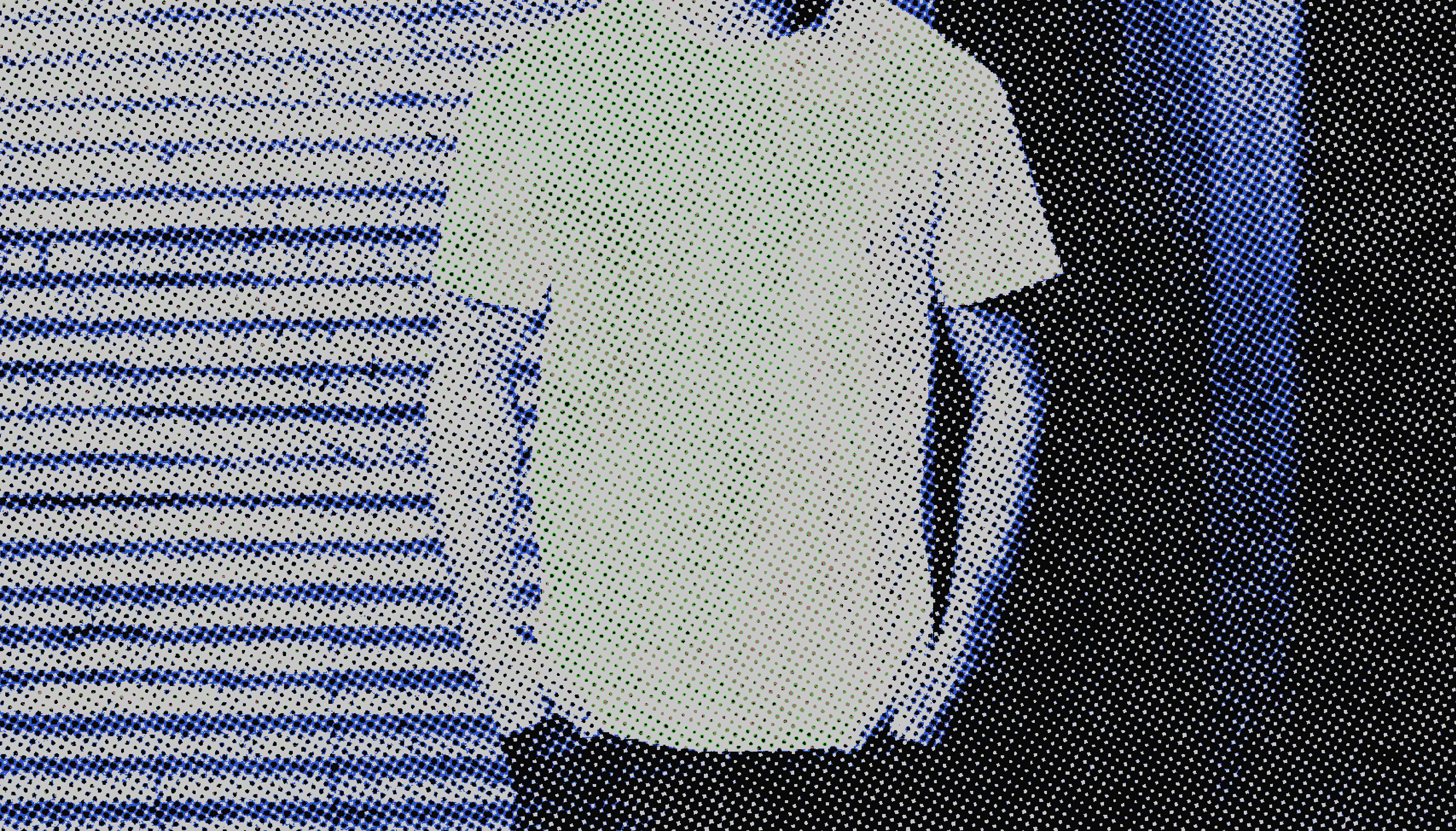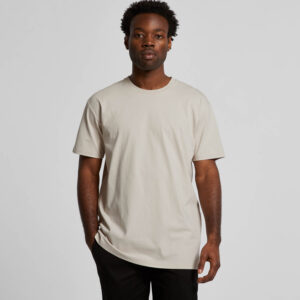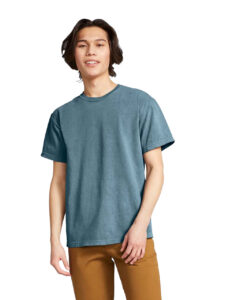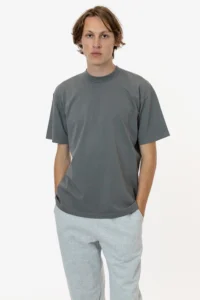With so many options to choose from, creating custom screen printed shirts can seem like an arduous task. Whether you’re an established brand looking to expand your merch catalog or a small business just starting out, making high quality products is key. Your merchandise should be a reflection of your brand, and no one wants to appear poorly made or low in quality. At Mello we aim to help all of our clients build better branded merch, and that typically starts with apparel. We’ve put together this guide to make the process easier and give you all the useful tips you should know when launching custom screen printed t-shirts and apparel.
Starting with the Basics
Has this ever happened to you? While doom scrolling on social media or browsing online you find the perfect graphic tee that makes you immediately hit that purchase button. Once the package comes in, you excitedly tear it open only to be let down by the low quality of the shirt it’s printed on leaving you majorly bummed out. Our goal is to make sure this doesn’t happen to your brand’s loyal customers.
Choosing the right blank shirt can make or break the success of your screen printed apparel line. Most of the blanks more commonly used in the past have fallen out of trend in recent years. The past fashion standard of thin form-fitting graphic tees has been replaced by an affinity for thicker shirts with a baggier fit and garment-dyed color. If major retailers like Urban Outfitters, Abercrombie, and Zara have transitioned to this style, it’s time to bring your own custom merch into this modern era.
When guiding clients on their merch journey, we at Mello have a few top recommendations to ensure your designs end up on modern, high quality shirts. Each option is 100% Mello approved, and we’ve broken them down by quality from lowest to highest.
1. AS Colour Staple Tee
Our low to mid range pick from AS Colour is the perfect go-to for a traditional screen printed tee when your brand is starting out or working with a limited budget. With a standard fit and mid-weight cotton, these blanks will look and feel like a traditional t-shirt, but the quality is turned up to an 11 compared to other more common lowest cost options.
2. Comfort Colors Garment Dyed Tee
Comparable to the staple tee, Comfort Colors offers a wide variety of garment dyed color options to push the standard tee a bit more into high-end boutique territory. For those unfamiliar, garment dying is a process where apparel is dyed after being cut and sewn resulting in a richer, more consistent color. If you’re looking for more longevity and a higher quality on a budget, we strongly recommend garment dyed pieces for your custom screen printed shirts.
3. LA Apparel Garment Dyed Crew
These blanks are sure to take your branded merch to the next level. LA Apparel’s Garment Dyed Crew is a great option for standing out amongst other brands’ custom apparel. While technically still a standard tee, this option feels more modern and the quality is top notch. These are definitely our number one pick if you want to maintain a more standard fit and mid-weight cotton.
4. AS Colour Heavy Tee
Our hands down #1 recommendation, the Heavy Tee truly feels like the highest end shirt you can find on the market. The slightly oversized fit and heavy 100% cotton perfectly aligns with modern big name retailers and will make your screen printed tees feel like a curated collection. The heavy tee carries a higher price tag, but it’s definitely worth it if you’re looking for peak quality. Your merch is a reflection of your brand, and this blank is sure to impress your customers. They’re also available in a faded style that achieves the perfect vintage tee aesthetic.
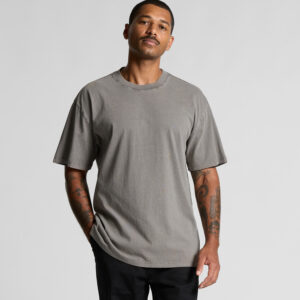
Art vs. Screen Printed T-Shirts
Now that you’ve found the perfect blank shirt for your screen printed apparel line, it’s time to talk design. Screen printing is a process limited by the number of colors printed onto the shirt. The artwork isn’t printed out like a standard photo printer, but is rather pressed onto the garment by using various screens of a single solid color ink. That being said, whatever design going on your apparel will need to be broken down into individual colors. Solid logos and artwork without too many fine lines or gradients won’t have any issue with this process.
Half-Toning
However, when using more photorealistic designs or artwork with multiple colors, the process can get tricky. Most complex artwork has to go through a process known as half-toning. This is where an image is broken down into a map of tiny shapes such as dots, lines, or ovals. By doing this, screen printers are able to create an optical illusion of gradients and slight variations in depth and tone. Keep in mind the more colors your image has, the higher the price tag will be. Here’s an example of how our team at Zach Mello created a photorealistic image for HAGS Fest’s merch line by only using a few colors.

Some custom merch companies won’t give you advice or accept artwork that isn’t “screen print ready.” However, we believe your team should be focused on your own brand’s initiatives, not becoming graphic designers overnight. At Mello, our experts will take your designs and ideas as they are and do the legwork needed to get them ready for print. We also offer full design retainer packages through Zach Mello to revamp your branding or create awesome custom shirt designs from scratch.
The Science Behind the Magic
As we touched on a bit in the previous section, screen printing is an interesting process with tons of science (and a little bit of magic) involved. For a quick breakdown on how it works, your artwork is printed onto transparent film sheets. From there we use a high powered light box to burn those films onto “screens” which are metal frames with finely woven silk fibers. When the design is burned onto a screen, the process makes it so the ink will only come out in the areas where your artwork exists. Next, the screens are calibrated to the exact position they need to be and ink is pressed onto the screens through the tiny openings made in the burning process. This is done for each individual color, which is why using more than 3-4 can become a bit challenging. Finally, the shirts are laid onto a dryer where the extreme heat causes the chemical compounds in the ink to cure onto the shirt.
You might be thinking, “why should I care about this?” The reason being is that the process can affect the quality of your brand’s screen printed shirts and apparel. There are three main types of ink used in screen printing, and they heavily impact the final result of your merchandise. When working with a screen printer, it’s important to be knowledgeable about the ink used so you can ask the right questions to ensure your branded merch is in line with quality expectations. Let’s take a look at these three inks’ pros and cons.
Plastisol
A traditional and standardized ink amongst screen printers, Plastisol is widely used on many screen printed T-shirts. Plastisol is a PVC thermoplastic ink that cures when extreme heat is applied. It is the lower-cost, user-friendly ink that many at home screen printers use as well as some large screen printing companies. This ink is easier to use compared to the other options and will leave a solid coating on both dark and light fabrics.
However, there are some key flaws if you’re aiming for the highest quality of merch. Because of its reaction to heat, Plastisol ink can be risky to iron. If the ink gets too hot, it will remelt and smear – ruining the garment. It’s also prone to cracking after repeated wears and washes, making the shirt appear old and unappealing. Lastly, Plastisol has what we refer to as a “higher hand.” This means that when grazing the garment with your hand, you can feel the plastic-like ink. The higher the opacity of the ink, the higher the hand. This is mostly an issue based on customer preference, however some brands want to steer clear of this feel as it can appear cheap.
Water Based
Water based inks use water as the main solvent in the curing process. When heated at an extremely high level, the water evaporates, curing the ink onto the shirt. Due to its penetration, these inks leave a very soft hand leaving the ink seamlessly blended into the softness of the shirt. This penetration is also better for textured pieces such as ribbed apparel or towels. The look and feel is a more desirable effect for some and screen printed t-shirts using water based inks are much less likely to deteriorate over time.
One key fault to note is that water based inks cannot always be perfectly matched to a Pantone color like Plastisol inks can. This is due to the variables that come with the fabric of the garment and ink deposit process. The other main drawbacks of water based inks are on the screen printer’s side, being harder to work with and requiring a much larger dryer to ensure the water fully evaporates. Lastly, water based inks should mostly be used on lighter colored garments.
Discharge
Very similar to water based inks, discharge inks deposit the ink into a garment leaving a soft hand. This will give your screen printed apparel a soft feel absent of hard plastic or texture. These are the preferred inks for darker colors such as black or navy when you desire a soft hand result. Garments using discharge ink will stand the test of time with minimal fading and without risk of cracking or smearing.
However, there are some key flaws that come into place considering the fabrics being used. Discharge ink should only be used on high quality cotton and does not work well with re-dyed garments. It can also be more costly than other two ink options. If you’re looking for bright white or colored designs on black apparel without any texture, this method is your best bet.
Alternatives to Screen Printed Shirts and Apparel
In 9/10 scenarios we will always recommend clients choose screen printing for their custom tees and apparel. It is by far the highest quality method and will produce the most professional level of merch. However, limitations can arise due to artwork and budget constraints. Because of this, we felt it important to describe a few alternatives to ensure every brand is included and can look to this article for advice.
Direct to Garment (DTG) Printing
Direct to Garment or DTG printing is a process where an individual t-shirt or apparel item is loaded onto a platen for an inkjet style printer to print the design on. A key benefit of this method comes from the fact there is virtually no color limit or artwork preparation needed. We’re aces at half-toning artwork so unless there is a high amount of minute detail or you don’t want your image to be altered in any way, there’s a chance it can still be screen printed. This method is also great for very small orders of 20 or less items since it doesn’t require the detailed setup as when screen printing.
You may be wondering why anyone wouldn’t choose this over screen printing since it seems so much easier. The answer to that is the finished quality. The hard plastic texture of these designs is even worse than Plastisol and the longevity of these items is much shorter than any other custom screen printed apparel process. It’s also good to note the quality of DTG printers can vary greatly. We’re proud of our results using this method, but highly encourage requesting a sample run to gauge the quality when working with other custom apparel companies. If you’re trying to maintain the highest quality in your merch, (which we definitely recommend) we’d advise going with this method only if you find yourself in one of the following three categories:
- When a design has a high number of varying colors which would result in a hefty price tag to screen print
- If a design contains photorealistic artwork that a client does not want altered in any way
- When a very low run of items is needed. (i.e. 1-20)
Dye Sublimation
A less common process for custom apparel compared to DTG or screen printing is dye sublimation. This is the same method used for a variety of non-apparel goods like coffee mugs, utilizing some pretty cool science to achieve a print. In short, dye sub designs are printed using special inks containing a polymer that reacts when heated onto polyester compounds. For a brief moment, the ink becomes gaseous and then clings to the polyester fabric molecules in an instant. The result is a permanent design that will almost never fade from its current state and feels soft to the touch like with water based and discharge inks.
As with DTG, there are some major flaws with this method. To start, it’s impossible to print white ink. This means that any white in your design will end up being the color of the actual shirt. Dye sublimation inks only react to polyester fabric, which if you’ve ever worn are not nearly as comfortable or breathable as cotton fabrics. You’re not limited to 100% polyester fabric apparel, however the higher concentration of polyester, the more clear the print will be. Think of the percentage of polyester as the opacity level of the finished artwork. As you bring it down, it becomes more and more transparent the lower the percentage. Dye sublimation is our lowest recommendation, and it is only beneficial if you specifically check all of these boxes below:
- When a design has a high number of varying colors and can’t be half-toned
- You want an end result that is soft to the touch and free of texture
- You’re fine with your design looking a tad transparent or low in opacity for a faded, vintage look
- Using poly shirts isn’t a concern for the overall quality of your merch
If you’ve made it this far, thank you for reading our deep dive into creating elevated screen printed shirts and apparel. At Mello, we are always striving to ensure our community is well informed when it comes to building their better branded merch. Feel free to reach out to us if you have any questions on your next project or submit a quote to get started today.
Keep it Mello!


